 Another M40 Basement Project
Another M40 Basement Project All Text, Graphics, Animations, Video, and Commentary on this website was created by, and is the intellectual property of m4040@m4040.com. All Rights Reserved. Unauthorized reproduction is punishable by up to a $500,000 fine or 5 years imprisonment for a first offense, and up to a $1,000,000 fine or up to 10 years imprisonment for subsequent offenses under the Digital Millenium Copyright Act (DMCA). Requests for use of this material should be forwarded to m4040@m4040.com. Why did I add this disclaimer? SEE WHY.
How to Turn a Ghurka Khukri Into a Very Formidable Field Knife
 Another M40 Basement Project
Another M40 Basement Project
For other projects and a little info on tools and techniques, see my Bladesmithing pages
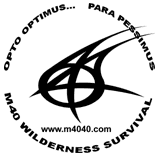 |
VISIT M40's WILDERNESS SURVIVAL STORE The best wilderness survival gear on the market! Backyard campers and Rambo wannabe's... go buy a Bear Grylls kit. When you get serious about your wilderness activities... come see my gear. Hikers, mountain bikers, cross country skiers, ATV'ers, off-roaders, and others whose activities carry them far and wide... discriminating outdoorsmen opt for quality gear. |
Background
Let me first start by saying that I have always been a big fan of the Ghurka Khukri knife. I bought my first Khukri when I was a kid, and I cannot profess that I knew what entailed a good blade for combat, camp or survival, but what I noticed right off the bat, is that the Khukri (once properly sharpened) was an extremely fearsome chopping tool. As I grew older, I began to acquire quite an extensive cutlery collection and a good understanding of blade craft and metallurgy.
Recently, I began looking for a good, all-around field knife. The best tools for this (in my opinion) are part bowie, part machete. A good portion of camp and survival chores center around chopping, whether dropping saplings and small trees to make shelter, or simply cutting and splitting firewood. I am still a big fan of high carbon steel. Stainless just doesn't cut it (pardon the pun). It loses its edge too quickly, and is too soft to stand up to severe use and abuse. Damascus steel is awesome stuff as far as taking and holding an edge, but has been known to delaminate under heavy chopping tasks.
Aside from the Khukri, one of the knives I use for this type of work is the Becker Brute. This knife is a full 15” in length (9.5” blade), and the high carbon steel is a full quarter inch thick. It also has a bit of the forward curve that Khukri fans will be familiar with. This important feature adds to its chopping prowess. It is a nice knife, and I’ve since added pouches to the sheath for a home-made survival kit. Even though the Becker is a wonderful knife, I still wish it had more forward curve and better weight. This is one of the factors that prompted me to modify a Khukri into something a bit more modern, and into a true workhorse for heavy field use.
Why a Khukri?
The forward cant geometry of the Khukri blade produces awesome chopping power by focusing the full weight of the strike at the crux. The angle also allows for better cutting for the same reason that an axe head is typically curved. As I mentioned above, I am a big fan of high carbon steel, and the Khukri fits that bill perfectly. Each Khukri is hand forged from a billet of leaf spring (typically acquired from trucks. Leaf springs are high carbon rolled steel (not drop forged, which often produces a breakable tool). These billets are then hammered to shape, and quenched. This process produces an extremely durable blade which will not break even under the most stressful use. For a History of the Ghurka tribes, the Khukri knife, and a primer on how it is made, CLICK HERE.
UPDATE
This page has generated a HUGE amount of feedback... more than I could have imagined. I guess I am not alone in my ongoing affinity for the venerable Khukri !! I get quite a few folks telling me they have ordered them from a variety of sources including Ebay. Almost to a person, they have paid TOO MUCH. DO NOT spend more than $20 on a military model khukri!
I have also received a LOT of requests from folks who are trying to pay me to modify Khukris for them. I will say it here to save myself some time answering emails... I do NOT sell any product or service on this site. I also don't have the time or inclination to perform side work. The amount of time and effort I put into the modification would require that I charge a price that would be unfair. If you are looking to spend some serious money on a Khukri, then there are a few alternatives. SEE THIS PAGE FOR KHUKRIS READY TO ROLL !
THE MODIFICATION
For starters, the Khukri handle is absolutely miserable to work with. Although the knife itself is an incredible chopping tool, the handle chops up ones hand almost as much as the blade does wood. First, the handle is fat in the hand, and the ridge that runs around the center of the handle needed to be cut down followed by the flared ends, all of which digs mercilessly at ones palm. The second item was the blade itself, which I sanded and wire wheeled to remove imperfections. I then blued all of the steel using Brownell’s awesome Oxpho-Blue, which is the best cold blueing I have yet found. See the before and after pictures in figures 1 and 2. For best results, either sandblast or hand-sand the surface before blueing.
Oxpho-Blue can be found HERE.
Note: The before and after pics are two different knives. I had done a good portion of the modification without photographing it, but have since purchased a second Khukri to mod for a friend. I used this second Khukri to illustrate the differences pre and post modification.

Figure 1: Before Handle Modification and Blueing

Figure 2: After Initial Handle Modification and Blueing
The next step I took towards making the knife into something I would take into the field is a decent cord wrapping of the handle. I used 550 lb.test Para Cord for the task. Besides being extremely durable, it is also comfortable in the hand, and has a wide array of survival uses. I made the handle modification such that it would be of a comfortable size and feel whether wrapped or not, thus if I ever needed the cord, the tool is still comfortable in hand. If you want to remove and replace the handle altogether, please see THIS PAGE FOR INSTRUCTIONS.

Figure 3: The Shoddy goat skin Sheath as comes with the knife
The last step I took was a much needed rebuild of the sheath. The original is wood wrapped in goatskin. Now I know that in that area of the world (India, Pakistan, etc) cows are not used for food or leather goods, but I must say that they should reconsider. Goatskin is the crappiest, thinnest, papery junk that ever graced (or disgraced) a sheath (see Figure 3). I peeled all of this away (it tears like construction paper) to expose the wood liner halves. These are decent to use, as the odd shape of the blade makes for difficulty when trying to construct a traditional sheath. I sanded these out, and then treated the wood with Thompson’s water seal. These were then painted olive drab, and I fashioned a heavy canvas exterior and heavy nylon strapping to make the frog and external sheath. The outer sheath was also strategically cord wrapped with 550 cord.
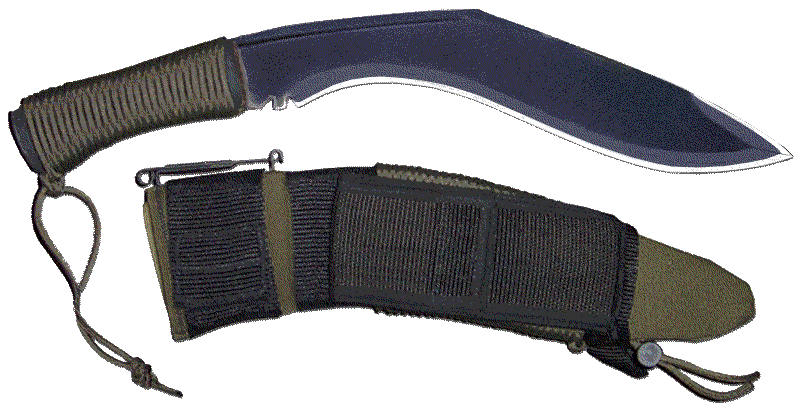
Figure 4: Nearly completed Knife and Sheath
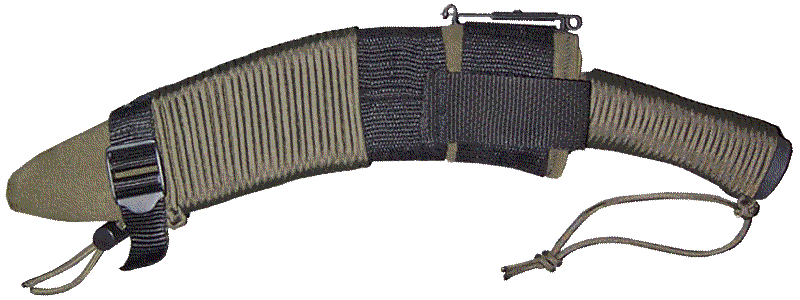
Figure 5: Backside View of Sheath and Knife showing ParaCord wrapping
I have just now made a larger external side pack for the sheath as shown in figure 6. The large pouch fits right over the smaller one. I carry a sharpening stone and a few basics in the smaller sheath, but have a very comprehensive survival kit in the larger pouch (Click HERE to see contents). This large kit has velcro attachment straps, and is therefore wearable either on the sheath as shown, or on the belt alongside the knife. This allows for a large survival kit to be carried when I'm traveling in unfamiliar areas, and just the basics when in familiar woods. The kit can also be worn alone, as it contains a small swiss army knife (and I also usually carry a Gerber Multi-Tool).
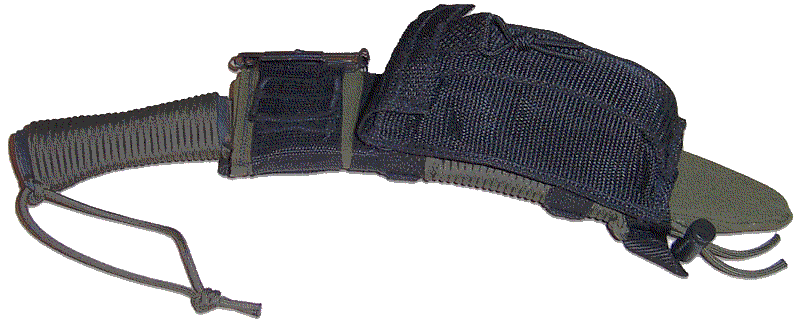
Figure 6: New Modular External Pouch
The latest modification I have made is to put a couple of inches of edge along the backside of the blade tip (see Figure 7). As you can see, I have decided that the knife was now ready for final honing. From the tip back to about 3 or 4 inches, I have brought it to almost shave sharp, and then the edge tapers down into a larger angle (more of an axe / machete edge) towards the middle, as this is the primary chopping area.

Figure 7: Closeup of Blade After Topside Edge Modification and Final Honing
I am still considering a few more modifications. I recently dipped the end of the sheath into a rubberizing tool dip. This will make the tip of the sheath more resistant to wear and tear. I will post pics as I take them. As this is my first attempt at modifying a Khukri, I am relatively pleased with the result, and the next one can only be better. Now I truly can say that I would carry this tool in the field. It is a joy to work with, and has a feel like no other knife. I enjoy doing this sort of work, but for those with less time and more money to throw around, you can now buy a modernized Khukri workhorse direct from the folks at the Cold Steel company. Their Khukri (Cold Steel Model 35ATCBB) seems to be top notch (I do not have one, but will trust that this knife meets their typically high standards). The Cold Steel will set one back anywhere from $100 to $150. Mine cost me about $20 and a little elbow grease. Ghurka Khukri’s are readily available on quite a few sites, and typically sell at about $20-$30. I get mine at Sarco ( see them at HERE ). Although they may look ornamental, the steel is quite good, and takes a very good edge with a bit of honing, and as you can see, they clean up real nice : )
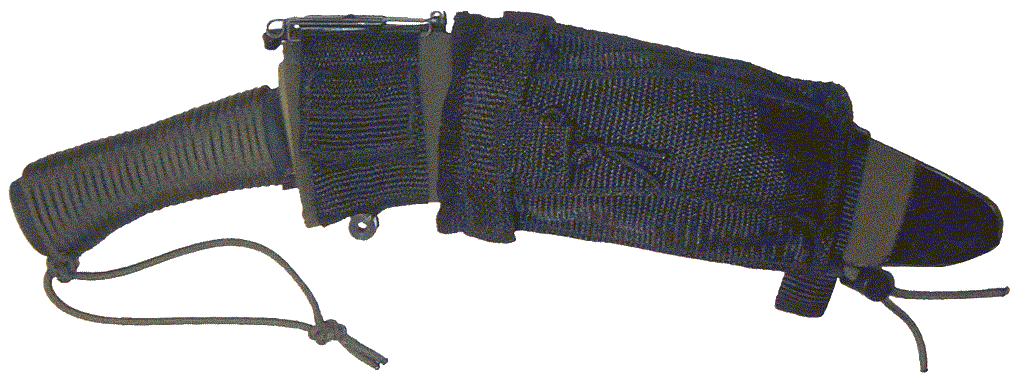
Figure 8: Final Sheath Modification (Rubberized Tip)
By the way, I have started a SECOND KHUKRI PROJECT !!!